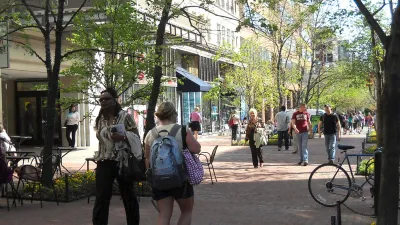Millennials and an aging Baby Boomer population have put a premium on "the hottest trend in real estate": walkability.

Via the Huffington Post, F. Kaid Benfield of PlaceMakers writes that the most sought after amenity for renters and buyers is now 'walkability'. Access to services, shops, restaurants and transportation is now a huge consideration for millennials and baby boomers, whether they prefer to live in the suburbs or in the urban core. Benfield cites a nationwide survey by the National Association of Realtors and Portland State University that found 'walkability' as an important factor in the selection of where people live.
Across all generations, the Realtors/Portland State survey found that an overwhelming majority of respondents - 79 percent - believe it to be very or somewhat important, in choosing a home, to be "within an easy walk of other places and things in the community." It also found that people who now live in such neighborhoods are especially satisfied with the quality of life in their communities. Fifty-four percent of those respondents who agreed with the statement "there are lots of places to walk nearby, such as shops, cafes, and restaurants" reported being very satisfied with the quality of life in their communities; only 41 percent of all respondents reported being very satisfied.
Benfield notes that while most cities across the United States have areas that can be considered 'walkable', there aren’t enough to meet demand.
And, because their supply is limited, prices for walkable locations are sky-high. Research has shown that each one-point increase in a home's Walk Score (a 100-point scale measuring an address's accessibility to walkable destinations) is associated with a $700 to $3000 increase in its value compared to less walkable homes of comparable size.
So what can be done to create more walkable areas in our cities and suburbs? Banfield offers a few good solutions, including the implementation of form-based codes and a focus on LEED for Neighborhood Development when updating that existing zoning codes.
FULL STORY: We Want More Walkable Neighborhoods -- but Can Our Communities Deliver?

Analysis: Cybertruck Fatality Rate Far Exceeds That of Ford Pinto
The Tesla Cybertruck was recalled seven times last year.

National Parks Layoffs Will Cause Communities to Lose Billions
Thousands of essential park workers were laid off this week, just before the busy spring break season.

Retro-silient?: America’s First “Eco-burb,” The Woodlands Turns 50
A master-planned community north of Houston offers lessons on green infrastructure and resilient design, but falls short of its founder’s lofty affordability and walkability goals.

Test News Post 1
This is a summary

Analysis: Cybertruck Fatality Rate Far Exceeds That of Ford Pinto
The Tesla Cybertruck was recalled seven times last year.

Test News Headline 46
Test for the image on the front page.
Urban Design for Planners 1: Software Tools
This six-course series explores essential urban design concepts using open source software and equips planners with the tools they need to participate fully in the urban design process.
Planning for Universal Design
Learn the tools for implementing Universal Design in planning regulations.
EMC Planning Group, Inc.
Planetizen
Planetizen
Mpact (formerly Rail~Volution)
Great Falls Development Authority, Inc.
HUDs Office of Policy Development and Research
NYU Wagner Graduate School of Public Service


























